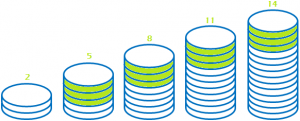Arithmetic Progression
Sequence: A sequence is a function whose domain is the set N of natural numbers.
Real Sequence: A sequence whose range is a subset of R is called a real sequence.
In other words, a real sequence is a function with domain N and the range a subset of the set R of real numbers.
Series: If a₁, a₂, … an … is a sequence, then the expression a₁ + a₂ + …………… + an is a series.
Progressions: It is not necessary that the term of a sequence always follow a certain pattern or they are described by some explicit formula for the nth term. Those sequences where terms follow certain patterns are called progressions.
Arithmetic Progression (A.P): A sequence is called an arithmetic progression if the difference of a term and the previous term is always same, i.e. an+1 – an = Constant (d) for all n ϵ N.
The constant difference, generally denoted by d is called the common difference.

Properties of an arithmetic progression:
- If a is the first term and d the common difference of an A.P., then the n th term is given by an = a + (n – 1 ) d
- A sequence is an A.P. if its nth term is of the form An + B i.e., a linear expression in n. The common difference in such a case is A i.e., the coefficient of n.
- If a constant is added to or substracted from each term of an A.P., then the resulting sequence is also an A.P. with the same common difference.
- If each term of a given A.P. is multiplied or divided by a non-zero constant k, then the resulting sequence is also an A.P. with common difference kd or d / k where d is the common difference of the given A.P.
- In a finite A.P. the sum of the terms equidistant from the beginning and end is always same and is equal to the sum of first and last term i.e.,
- ak – an-(k-1) = a₁ + an for all k = 1, 2, 3 …
- Three numbers a, b, c are in A.P. if 2b = a + c
- If the terms of an A.P. are chosen at regular intervals, then they form an A.P.
- If an,an+1 and an+2 are three consecutive terms of an A.P., then 2an+1 = an + an+2
Selection of terms in an A.P: Sometimes we require certain number of terms in A.P. The following ways of selecting terms are generally very convenient.
|
Number of terms |
Terms |
Common difference |
| 3 | a – d, a + d |
d |
|
4 |
a – 3d, a – d, a + d, a + 3d | 2d |
| 5 | a – 2d, a – d, a + d, a + 2d |
d |
Example: If the fourth power of the common difference of an A.P. with integer entries is added to the product of any four consecutive terms of it. Prove that the resulting sum is the square of an integer.
Solution: Let a – 3d, a – d, a + d, a + 3d be four consecutive terms of an A.P. with integer terms. Clearly, the common difference is 2d
Since the terms are integers, therefore a and d are also integers.
Also,
= (a – 3d) (a – d) (a + d) (a + 3d) + (2d)⁴
= (a² – 9d²) (a² – d²) + 16d⁴
= a⁴ – 10a²d² + 9d⁴ + 16d⁴
= a⁴ – 10a²d² + 25d⁴a⁴
(a² – 5d²)², which is square of an integer as ’a’ and ‘d’ are integers.
Sum to n terms of an A.P: The sum Sn of n terms of an A.P. with first term a and common difference d is given by \({{S}_{n}}=\frac{n}{2}\left[ 2a+\left( n-1 \right)d \right]\)
Also,
\({{S}_{n}}=\frac{n}{2}\left[ a+l \right]\)
Where l = last term = a + (n – 1)d.
